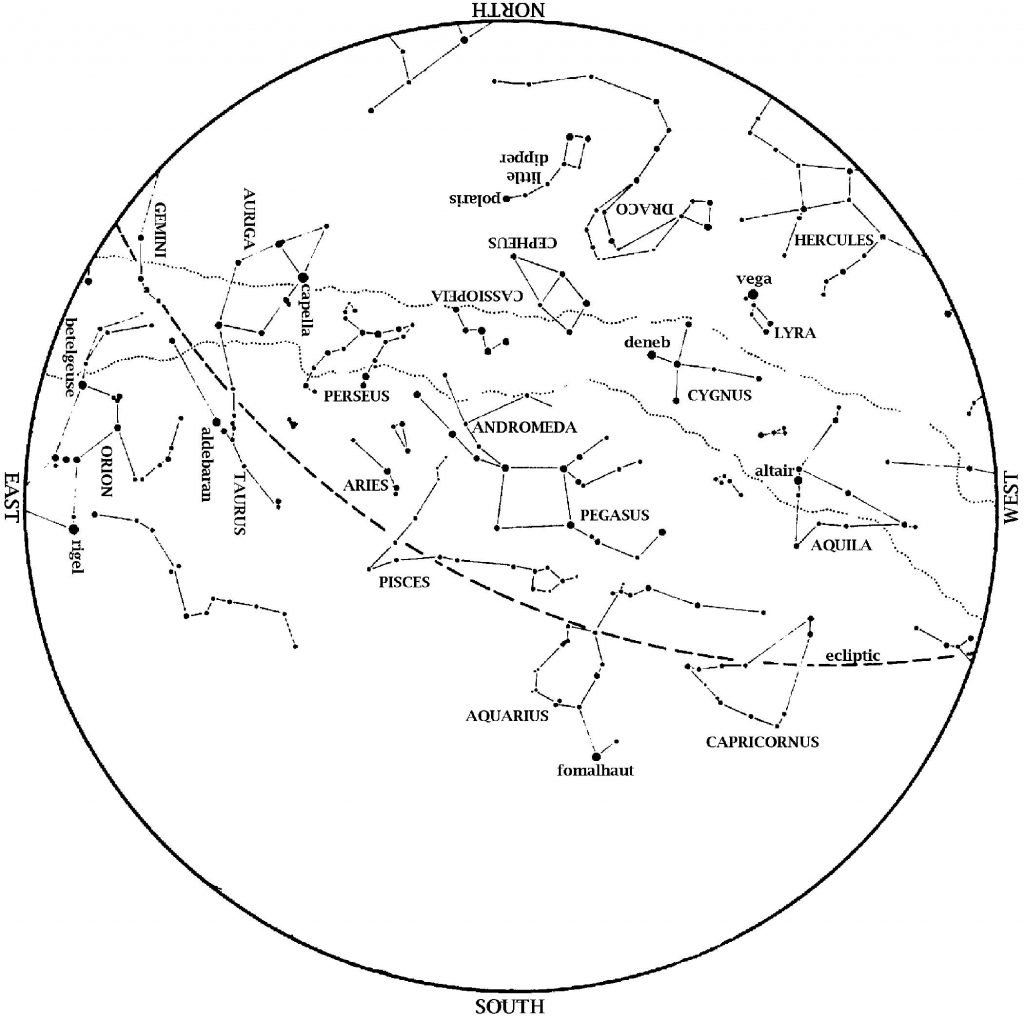
This star map shows the Houston sky at 8 pm CST on December 1, 7 pm CST on December 15, and dusk on December 31. To use the map, put the direction you are facing at the bottom
.
Mars is higher in the southeast at dawn than it was last month. It is in Virgo, leaving Spica and approaching Jupiter in Libra.
Jupiter is low in the southeast at dawn; watch Mars approach it this month.
Saturn is lost in the Sun’s glare and out of sight this month.
Venus is also lost in the Sun’s glare and invisible.
The Summer Triangle sets in the west. Watch for the Great Square of Pegasus almost overhead at dusk now and in the west by Christmas. Taurus, the Bull rises in the east. Look for the Pleiades star cluster above reddish Aldebaran. Dazzling Orion, the Hunter rises shortly after dusk (by month’s end, it is already up at dusk). As Orion enters the evening sky, we transition from the relatively dim evening skies of autumn to the brilliant stars of winter. We are beginning to face away from the center of the galaxy, looking at stars behind us in our own part of our galaxy (the Orion Spur).
Moon Phases in December 2017:
Full Dec. 3, 9:46 a.m. Last Quarter Dec. 10, 1:51 a.m.
New Dec. 18, 12:30 a.m. 1st Quarter Dec. 26, 3:20 a.m.
The Super Moon And The Winter Solstice
The Full Moon of December 3 happens to coincide with perigee (Moon’s closest approach to Earth), making this another ‘supermoon’. Although the Moon is slightly larger in the sky because it is also closer than usual, an adult’s pinky held at arm’s length still covers it up.
At 10:27 am on Thursday, December 21, the Sun is directly overhead as seen from the Tropic of Capricorn—the farthest point south from which the Sun ever appears overhead. This means that Earth’s North Pole is tilted away from the Sun as much as possible, and that this moment is the winter solstice for us in the Northern Hemisphere. On this date the Sun takes its lowest, shortest path across our sky as Earth turns under it. In Houston, we have ten hours, fourteen minutes of daylight, less than on any other day of the year. The South Pole, on the other hand, is tilted towards the Sun as much as possible on the 21st. for folks south of the equator, this is the summer solstice, with more daylight than any other day of the year.
You will notice, however, that sunset on New Year’s Eve is up to ten minutes later than on December 1. Why, if the 31st is closer to the solstice? Although the shortest day (least daylight) occurs on December 21, the earliest sunset occurs for us about December 1. This is because the Sun’s apparent positon in our sky varies like a sine wave; there is little difference in the Sun’s apparent height for about a month before and after the solstice. Due to Earth’s tilt, the Sun does indeed take a shorter, lower path across the sky on December 21 than on December 1, but only by about 1.5 degrees (your pinky at arm’s length blocks one degree). Meanwhile, Earth is slightly accelerating as it approaches perihelion just after the new year. This makes both sunrise and sunset happen a little earlier each night during December. Near the solstice, this small effect can dominate. Since most of us sleep through sunrise and watch sunset, days will seem to lengthen from December 1-21 when they are in fact still getting shorter.
George Observatory is open to the public once again! Come join us any clear Saturday night.
Clear Skies!

